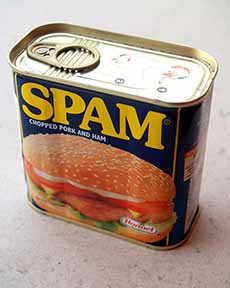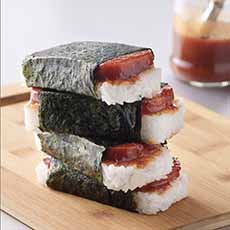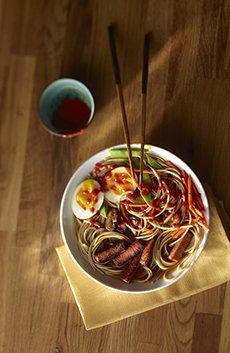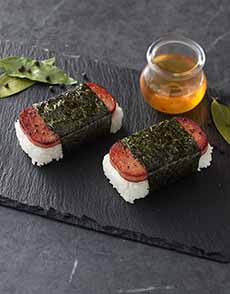SPAM Recipes For National SPAM Day, Plus, What Is SPAM?
|
July 31st is “unofficial” National SPAM Day. It’s unofficial because when we contacted the brand, they told us the holiday wasn’t established by or acknowledged by them. In these Internet times, anyone can declare any holiday and get it picked up through the Internet. So we’re certain that the millions of SPAM fans the world over will want to celebrate. Plus, August 8th is National Spam Musubi Day. That’s a lot of Spam in just one week. There’s something extra to celebrate in 2022: It’s SPAM’s 85th birthday! The brand offered us these facts: A brand of luncheon meat from Hormel Foods, SPAM is a 12-ounce canned loaf of ground and seasoned meat (photo #1). It’s a combination of ground pork and ham mixed with water, salt, sugar, and sodium nitrite (for the pink color). That’s the original recipe. Modified potato starch was added in 2009 to minimize the thick layer of gelatin on the top of the loaf. During the Great Depression (1929-1939), SPAM helped to fill the need for inexpensive meat products, which added protein to the diet (and yes, fat, salt, and sugar). Today, SPAM is often used in place of bacon or ham in everything from breakfast meat, sandwiches, and stir-fries to tacos and quesadillas. Search online for “SPAM recipes” and you’ll find all-American mac and cheese with SPAM (photo #3) as well as spaghetti and meatballs (the latter made from puréed SPAM), loaded baked potatoes, and international dishes like pad Thai. After years working in Chicago slaughterhouses, George A. Hormel founded his own slaughterhouse and meatpacking facility in Austin, Minnesota in 1891. Its specialty was processing whole hogs, beef, and sausage casings. George’s son Jay Hormel succeeded his father as president in 1929. One of the products, sold to deli and sandwich counters, was a six-pound loaf of pork luncheon meat. Based on its popularity, Jay Hormel designed a variation for home use. In 1937, Hormel Foods produced its now-iconic 12-ounce loaf of SPAM luncheon meat in a shelf-stable can (photo #1). The loaf used ground pork shoulder, which at the time was not a desirable cut of the hog. SPAM became an affordable meat substitute for families on a tight budget. As previously mentioned, the original recipe remained unchanged until potato starch was added in 2009, due to customer requests to lessen the gelatin layer. The gelatin layer naturally forms when meat is cooked and canned. To make it smaller was a purely aesthetic choice—and Hormel listened to their consumers [source]. The name SPAM was suggested at a New Year’s Eve party. Jay Hormel launched a naming contest for the new product, and the brother of a vice president quickly said: “SPAM” (a combination of “spice” and “ham,” even though there was no spice in the product). He won a $100 prize, worth about $1900 in today’s money. The U.S. entered World War II in 1941, and more than 100 million pounds of SPAM were shipped abroad to feed the troops. With deployed servicemen often eating SPAM three times a day, when they returned home most did not want to see it again anytime soon. However, in Hawaii, because of sanctions on fishing, SPAM became an important substitute for fish and meat—a precious source of nourishment during a time of food rationing. Similarly in the Philippines—a former U.S. colony—war rationing eventually led to the incorporation of SPAM into the cuisine. SPAMsilog, the addition of SPAM to the Filipino breakfast staple garlic fried rice, has become a favorite in many Filipino households [source]. In Japan and Korea, where the populations were on the point of starvation, cans of SPAM that were shipped in were a blessing, turned into a stew with broth and spices. In Korea, budae jjigae—which literally translates to “army base stew”—is still on the menu (here’s the recipe). In Hong Kong, SPAM and eggs in a soft bun are the local equivalent of ham and eggs on a roll at a U.S. deli (the recipe). Today, Korea is the world’s second-largest consumer of SPAM, after the U.S. (and the U.S. population is almost seven times larger). SPAM is considered a gourmet item across Asia, and is gifted for the Lunar New Year, packaged in gift boxes along with cooking oil and seasonings [source]. In the decades after World War II, as native Koreans and Japanese migrated to Hawaii, food culture in the Hawaiian Islands became even more intertwined. Japanese immigrants to Hawaii are credited with inventing SPAM musubi, a Hawaiian version of a Japanese rice ball (called onigiri or musubi). Musubi uses SPAM instead of fish, meat, or vegetables inside of the rice ball. While some SPAM musubi may look like nigiri sushi, note that sushi is made with vinegared rice. Musubi, on the other hand, is made with plain steamed rice. You can see the adoption of SPAM in communities worldwide, and with international SPAM flavors that include Portuguese Sausage Seasoning, Teriyaki, and Caribbean Tocino Seasoning. Email spam (lowercase), also referred to as junk email or simply spam, refers to unsolicited email messages sent in bulk. The process is known as “spamming.” The name comes from a Monty Python sketch, (watch it, below!) where the name of the canned pork product, SPAM, is annoying and unavoidable. The term was first used in 1993 in a post from USENET user Richard Depew. It was the result of a bug in a software program that caused 200 messages to go out to the news.admin.policy newsgroup. But that was only the beginning (as we all know too well). You can download a PDF of the history of spam email here. |
|
|
|
CHECK OUT WHAT’S HAPPENING ON OUR HOME PAGE, THENIBBLE.COM.
|
||










